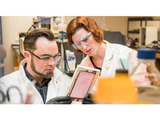UMBC’s Erin Lavik receives National Eye Institute funding
to create “living model of the human retina”
More than 200 million people around the world have visual impairments, making retinal research crucial to the development of more effective treatment plans. To that end, Erin Lavik, professor of chemical, biochemical and environmental engineering, and her collaborators have received funding from the National Eye Institute to develop a screen printing technique for human eye tissue.
Lavik and her team have proposed a method of layering adult stem cells in a way that is structurally similar to human retinas. Their idea was selected by the National Eye Institute’s 3-D Retina Organoid Challenge (3-D ROC) to receive one year of funding to create a model of the human retina, the part of the eye that is sensitive to light.
“Eye diseases have a tremendous impact on people’s quality of life and function,” says Lavik. “We do not have good models for studying these diseases, but it is our hope that we can use this prize to build new models of the eye that can be screened rapidly to allow researchers to not only understand eye diseases but to look for new therapies.”
Her work will allow researchers to address specific challenges to understand eye diseases or test eye therapies. Lavik is collaborating with Steve Bernstein, professor of ophthalmology and visual sciences at the University of Maryland School of Medicine, Adam Day ’16, chemical engineering, Ph.D. ’23, chemical engineering, and Bryan Ibarra, a student at the University of Miami, who worked in her lab over the summer. The team’s approach is simple and easy to reproduce, and uses inexpensive materials that can be found online, says Lavik.
After the funding ends, Lavik and her collaborators will be able to submit a proposal for the second phase of the 3-D ROC program. The NEI, a part of the National Institutes of Health, received 13 proposals for the first phase of the project.
Posted: November 10, 2017, 9:21 AM
